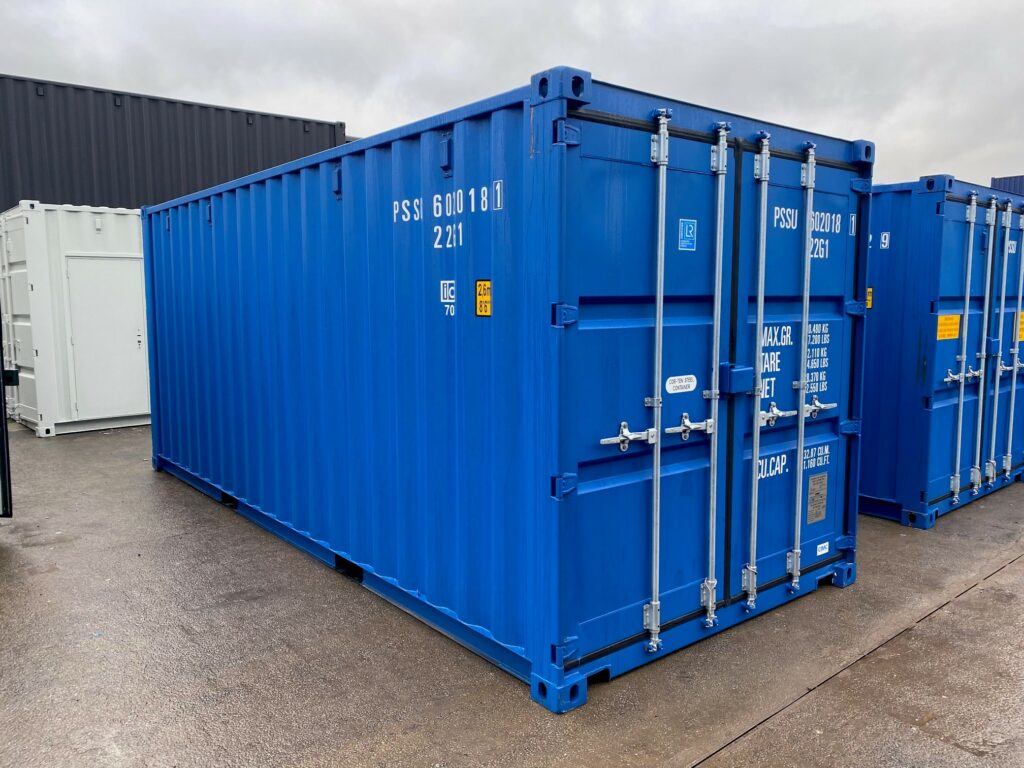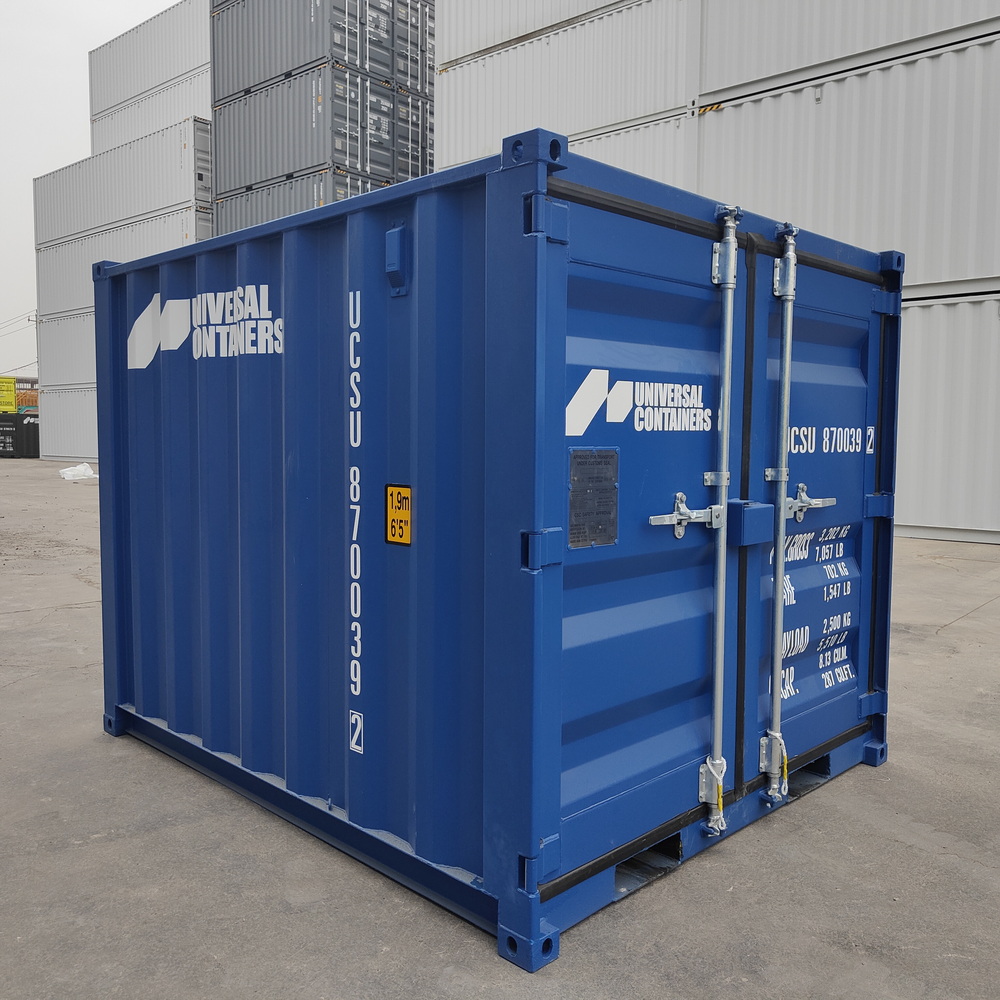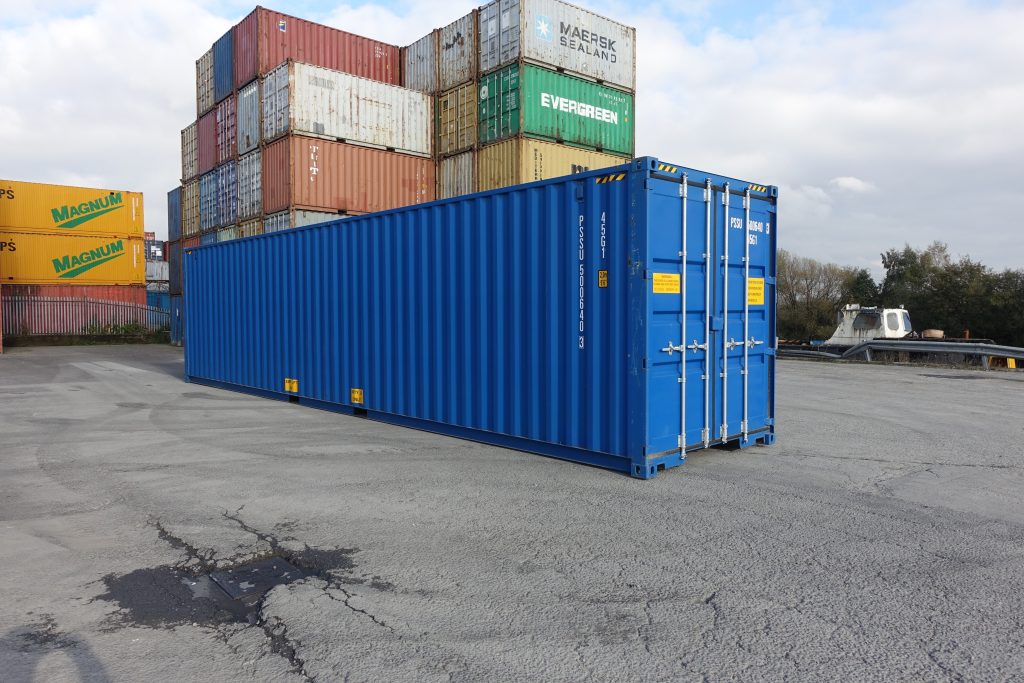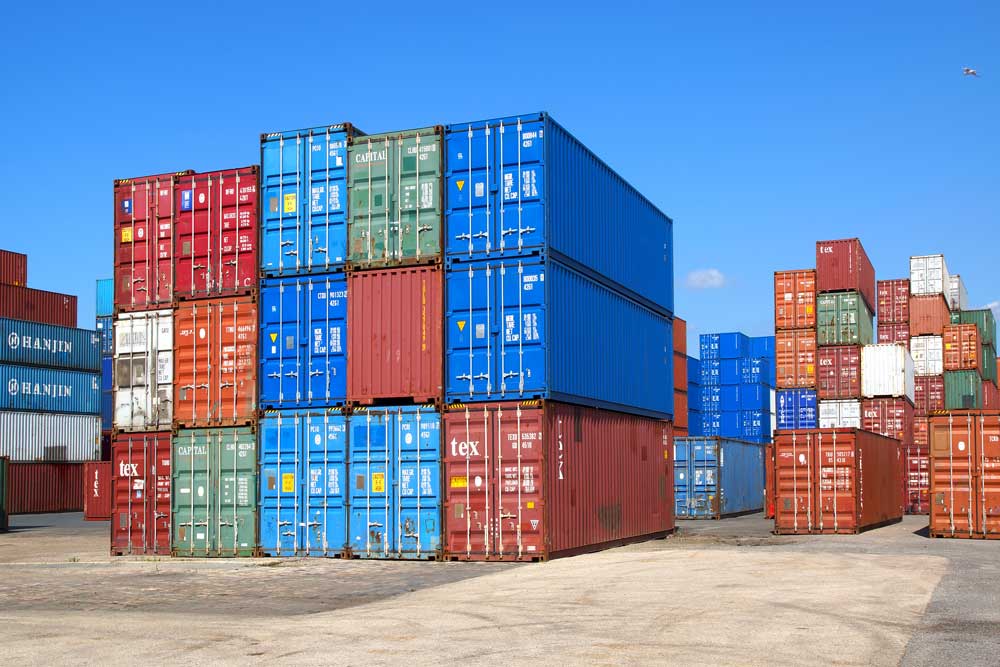Shipping containers, originally designed for the straightforward task of moving goods across oceans, have experienced a significant surge in popularity for a number of unconventional uses. No longer is the shipping container JUST a shipping container. Once simply the mainstay of ports and docks, these steel boxes are now commonly seen in urban landscapes, rural settings, and everywhere in between.
As shipping containers transition from the seas to our streets and beyond, understanding various shipping container sizes becomes imperative. Each size offers unique advantages, catering to specific needs and applications.
Shipping container sizes
When it comes to standard shipping containers, a few dimensions are globally recognised and extensively used due to their versatility and convenience in handling. The most common shipping container sizes include 20 foot and 40 foot shipping containers, which are widely used for shipping and storage due to their optimal balance between space and ease of transport.
These standard sizes ensure uniformity, making stacking, loading, and transport systematically efficient across various modes of freight, such as ship, rail, and truck. The standardised dimensions also make it simpler for these containers to be repurposed into a variety of uses, from housing to office space, catering to a broad spectrum of needs and industries.
20ft shipping container dimensions
The 20 foot shipping container is one of the most commonly used container sizes. Its compact size makes it a preferred choice for shipping various goods, especially for small to medium-sized cargoes.
These shipping containers primarily come in two distinct variations: the standard and the high cube. Both standard and high cube 20 foot containers maintain the same length and width, ensuring compatibility with global shipping and handling processes, while offering flexibility to cater to diverse cargo needs.
Standard 20ft shipping container dimensions

The common dimensions of a standard 20ft shipping container are approximately 20 feet (6.096m) in length, 8 feet (2.438m) in width, and 8.5 feet (2.590m) in height. With a capacity of around 1,170 cubic feet (33.1 cubic metres), it can accommodate a payload of approximately 48,000 to 52,000 pounds (≈ 22 to 23.6 tonnes) of cargo.
High cube 20ft shipping container dimensions

For those requiring extra vertical space, the 20 foot high cube container is an optimal choice. It maintains the length and width of its standard counterpart but offers an additional foot in height, measuring around 9.5 feet (2.895m) tall. This additional height provides more volume making the capacity of a 20-foot high cube container typically around 1,172 cubic feet (33.2 cubic metres).
20ft shipping container internal dimensions
Knowing the internal dimensions of a 20ft shipping container is crucial when planning the shipment or storage of goods, as it can dictate the volume of items that can be accommodated.
For a standard 20 foot shipping container, the interior dimensions are approximately 19ft 4ins (5.898m) in length, 7ft 8ins (2.352m) in width, and 7ft 10ins (2.393m) in height. On the other hand, the high cube variant, while retaining the same length and width as the standard shipping container, at 19 feet 4 inches (5.898m) and 7 feet 8 inches (2.352m) respectively, has the increased vertical height of 8 feet 10 inches (2.698m).
40ft shipping container dimensions
In contrast, the standard 40 foot shipping container doubles the available storage space compared to its 20 foot counterpart. Given the expansive size of these shipping containers, it is predominantly used for transporting voluminous or heavy goods, making it an essential asset for industries dealing with large-scale products or bulk items, such as furniture, machinery, and vehicles.
Just like its 20 foot counterparts, 40 foot shipping containers predominantly come in two variations: standard and high cube.
Standard 40ft shipping container dimensions

The standard 40 foot shipping container typically measures 40 feet (12.19m) in length, 8 feet (2.438m) in width, and 8.5 feet (2.590m) in height, providing about 2,390 cubic feet of internal capacity. Due to the large size of these containers, they can handle a substantial payload, roughly around 59,000 pounds (≈26.77 tonnes), depending on the specific model and manufacturer.
High cube 40ft shipping container dimensions

While matching in length and width, the 40 foot high cube shipping container provides an additional foot in height, reaching 9.5 feet (2.895m). This extra vertical space in the high cube model brings the capacity to roughly 2,700 cubic feet (76.45 cubic metres). However, although these containers have an extra foot of vertical space, their payload doesn’t differ much in comparison to the standard models and, again, is approximately 59,000 pounds (≈26.77 tonnes) of cargo.
In any case, it’s important to consider the container’s tare weight (the empty weight of the shipping container) as well, which is usually around 8,750 pounds (3,970 kg) when planning the cargo for these containers.
40ft shipping container internal dimensions
The internal dimensions of a 40ft shipping container play a pivotal role in determining the quantity and type of goods that can be transported or stored within it.
The interior dimensions of a standard 40ft container are approximately 39ft 5ins (12.032m) in length, 7ft 8ins (2.352m) in width, and 7ft 10ins (2.393m) in height. Alternatively, the 40 foot high cube shipping container preserves the length of 39ft 5ins (12.032m) and width of 7ft 8ins (2.352m), but provides an elevated height of 8ft 10ins (2.698m).
Small shipping container sizes
Small shipping containers, including the 8 foot, 9 foot, and 10 foot variants, provide compact and efficient storage solutions for situations when space is limited or where less volume is required for more compact solutions. Interestingly, these smaller-sized containers are often created by cutting down larger standard containers, adapting them to meet the specific demands of smaller storage or shipment needs.
8ft shipping container dimensions

An 8 foot shipping container is one of the smallest-sized containers available and is optimal for compact spaces and smaller storage needs. Typically, an 8ft container has approximate dimensions of 8 feet (2.438m) in length, 7 feet (2.134m) in width, and 7 feet, 6 inches (2.286m) in height.
The payload and internal capacity of 8ft containers can vary depending on the specific build and manufacturer, but generally, these containers can have a payload of around 6,000 to 7,000 pounds (approximately 2.7 to 3.2 tonnes). As for the internal capacity, it will typically have a volume of around 350 to 400 cubic feet (approximately 9.9 to 11.3 cubic metres), given the usual dimensions of the 8 foot containers.
9ft shipping container dimensions

A 9 foot shipping container, slightly larger than its 8ft counterpart, offers a touch more room while remaining a great fit for areas with limited space. Usually, a 9 foot container is 9 feet (2.743m) in length, 7 feet (2.134m) in width, and 7 feet, 6 inches (2.286m) in height.
The payload and internal capacity can differ based on the manufacturer and the specific design, but on average, a 9ft container might offer a payload ranging from 6,500 to 7,500 pounds (approximately 2.9 to 3.4 tonnes). Considering its dimensions, the internal volume would generally be somewhere between 390 to 450 cubic feet (approximately 11.3 to 12.7 cubic metres), making it a slightly more spacious option for those requiring that extra cubic footage without a significant jump in size.
10ft shipping container dimensions

A 10 foot shipping container is usually approximately 10 feet (3.048m) in length, 8 feet (2.438m) in width, and 8.5 feet (2.591m) in height. The payload and internal capacity can fluctuate depending on how it was cut down from a larger model and the specific design, but generally, a 10ft container can have a payload ranging from 8,000 to 9,000 pounds (approximately 3.6 to 4.1 tonnes) and can offer a volume of around 560 to 600 cubic feet (approximately 15.9 to 17 cubic metres).
Large shipping container sizes
Containers that exceed the standard 20ft and 40ft sizes are categorised as large shipping containers, with lengths that can reach up to 45ft, 48ft, and even 53ft, offering expansive internal capacities to accommodate a multitude of goods.
Designed to accommodate specific needs, such as oversized cargo or specialised industrial equipment. These large, and sometimes custom-designed containers, play a big part in the seamless transportation of a wide array of goods, aligning with diverse logistical demands and facilitating global trade and commerce by allowing more flexibility and adaptability in cargo management.
45ft shipping container dimensions
The big daddy of the bunch, the 45ft container is probably the biggest size you’ll be able to get your mitts on for both commercial and domestic use.

45 foot shipping containers measure approximately 45 feet (13.716m) in length, 8 feet (2.438m) in width, and 9.5 feet (2.896m) in height. The payload and internal capacity of these containers can also see variations depending on their make and model, but generally, a 45ft container can hold around 65,000 to 70,000 pounds (approximately 29.5 to 31.8 tonnes) and is equipped to accommodate approximately 3,000 cubic feet (around 85 cubic metres) of goods.
Looking for more information on how much shipping containers actually cost?
Understanding the costs can help you make informed decisions, whether you’re purchasing for shipping, storage, or conversion. Factors such as size and condition can significantly influence the price of shipping containers.
Check out our guide for insights on container sizes and the factors that affect their cost.
Read moreCommon uses for different sizes of shipping containers
Shipping containers have transcended their original purpose of transporting goods and have evolved into versatile structures serving numerous applications across different industries. Whether it be for their initial intent of shipping goods and storage, or more unconventional uses such as transforming them into living and working spaces, the diverse range of container sizes, from the compact 8ft units to the colossal 45ft ones, ensures that there is a container suitable for every need.
Each shipping container size can be tailored to meet specific demands and their adaptability has led to innovative applications, contributing significantly to industries like construction, hospitality, and agriculture. By understanding the common uses of these diverse sizes, it can help you optimise their benefits, catering to both conventional and unconventional requirements with unparalleled efficacy.
Uses for 20ft shipping containers
The 20ft shipping container tops our list of most popular containers to buy. There are loads of reasons for this, but the main one being that its “middleman” size, sitting between our 10ft and 40ft containers, means that it’s the most common choice for container conversions, as it’s not too big or too small, but just right.
Their standard dimensions and substantial build make them a preferred choice for different storage purposes, including storing machinery, furniture, and palletised cargo. The 20ft container is probably the most appropriate size for domestic ventures, meaning that if you were perhaps thinking of a shipping container shed or garage conversion, a garden room conversion, or the likes, you wouldn’t lose your garden as a result.
Their compact and portable nature has sparked innovation, leading to their transformation into modular homes and offices, providing comfortable and customizable living and working spaces with the addition of necessary amenities and modifications. Even for leisure purposes, some inventive minds have reimagined 20ft containers as unique above-ground swimming pools.
They are also commonly used for creating dynamic pop-up shops and cafés, offering a flexible and relocatable retail solution ideal for entrepreneurs and businesses.
Uses for 40ft shipping containers
The expansive dimensions of these containers make them a preferred choice for transporting large volumes of goods and heavy machinery. However, while a 20 foot container might be perfect for a cosy studio or a compact storage solution, a 40 foot shipping container might be more suitable for a spacious home or a larger retail space.
Their large size and versatility perfectly serves as spacious modular homes, offices, and commercial spaces, as they can be fitted with a range of amenities and utilities to ensure comfort and functionality. Their size advantage over 20 foot shipping containers makes them ideal for larger commercial setups, like expansive pop-up stores, restaurants, or even art galleries offering a unique aesthetic and substantial area to accommodate various needs.
Additionally, agricultural enterprises often leverage their extensive volume for storing sizable equipment, large quantities of feed, or harvested produce, highlighting their adaptability and the growing recognition of their potential across a number of industries.
Uses for smaller shipping containers
Smaller shipping containers, like the 8ft, 9ft, and 10ft units, makes them suitable for transporting smaller cargo quantities, optimising freight for businesses with lesser shipping needs.
They are often used to address a range of domestic storage needs, thanks to their compact dimensions and adaptability. These containers are ideal for confined spaces and smaller storage requirements in residential areas for secure storage of household items, garden supplies, motorbike storage pods or bicycles. Many innovative minds have also transformed these containers into tiny homes, hobby rooms, or personalised workshops, leveraging their manageable size and customizable nature.
Businesses often repurpose these smaller containers into compact mobile offices or kiosks, secure storage units or as construction site storage, benefiting from their portability and ease of modification and catering to those looking for mobility and flexibility.
Uses for large shipping containers
Larger shipping containers, those exceeding 45 feet, are commonly used for addressing extensive storage and unique functional requirements across various sectors, making them ideal for oversized and voluminous goods. These containers, due to their expansive space, are well suited for transporting substantial cargo like large vehicles, machinery, and bulk commodities, ensuring the secure and efficient transit of goods integral to industries such as manufacturing and agriculture.
Beyond logistical applications, these larger units are often repurposed to create extensive modular constructions like multi-unit housing complexes, large-scale office spaces, or industrial facilities, providing substantial area and flexibility. These large containers can also be used in constructing extensive commercial spaces and warehouses, offering scalable and sustainable building solutions.
The bottom line
The world of shipping containers extends far beyond mere cargo transport, reflecting a symphony of innovation, adaptability, and sustainability. From the compact 8ft units, ideal for personal storage and boutique businesses, to the colossal containers exceeding 45ft, designed for large-scale operations and expansive constructions, each size serves a myriad of purposes tailored to specific needs. Whether it’s repurposing them into contemporary living spaces, creative retail outlets or vital agricultural storage, their application possibilities are vast and versatile.
Understanding the dimensions and capacities of each size category enables individuals and businesses to maximise their potential, turning these metal boxes into solutions that cater to a wide range of challenges. As we continue to reimagine and innovate, shipping containers stand as a testament to human ingenuity, illustrating how we can transform the ordinary into the extraordinary, meeting the evolving demands of a dynamic world.
Was that useful? We hope so! If you have something specific in mind you’d like to know more about, feel free to drop us a line, or you can have a good scan through all our shipping container sizes for sale and shipping containers for hire. The choice is yours!
Looking for a completely custom solution?
We have a wide range of base containers that can be customised to your needs, however we
realise
that
sometimes you need something completely ‘Outside the box’.
Contact us and one of our experts will be in touch to help design the container of your
dreams





